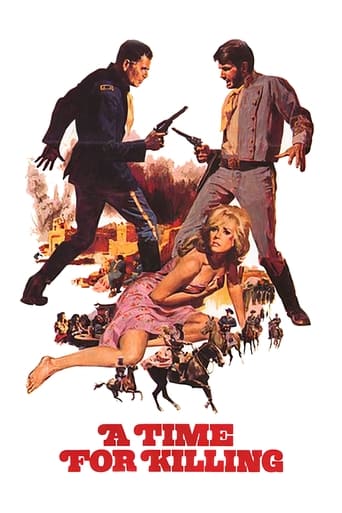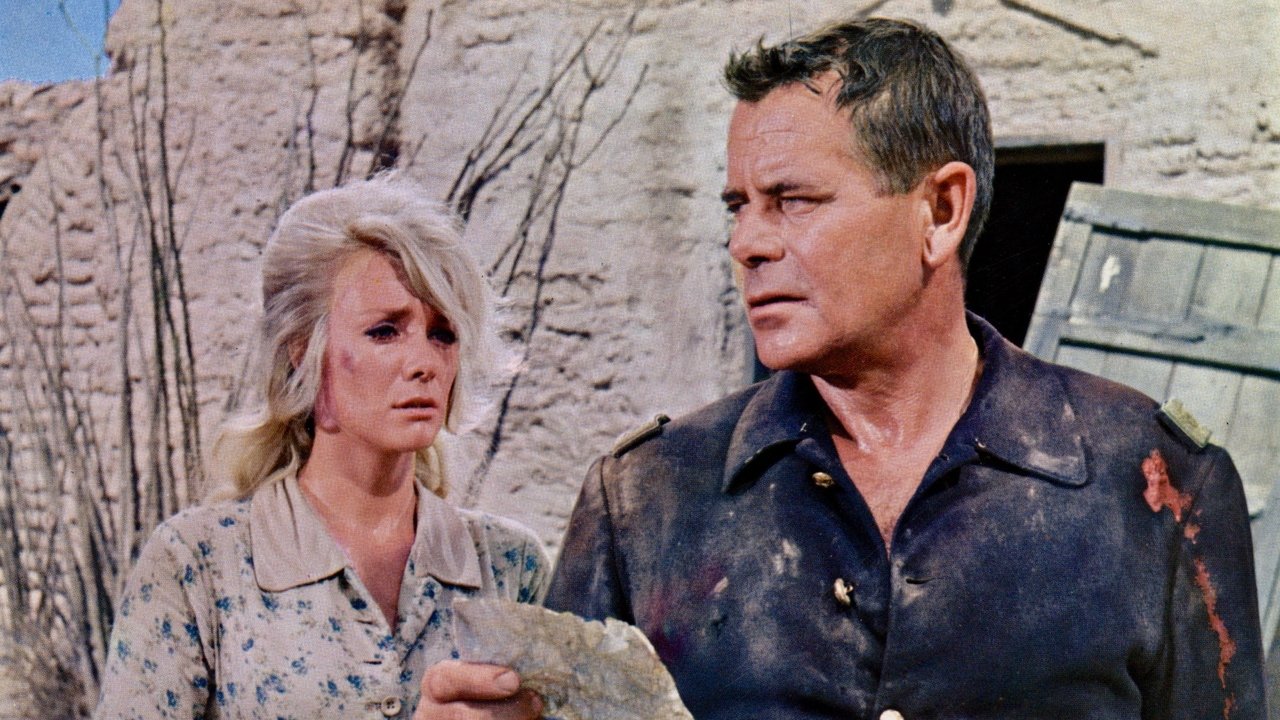classicsoncall
I'm sitting here trying to come up with some insightful things to say about this picture but I'm coming up blank. For me it was a so-so cavalry Western with a Civil War backdrop, and what I found interesting more so than the story was a handful of observations made along the way about the way the picture was filmed. Like, was it possible to have a woman as gorgeous as Inger Stevens show up at a Union prison camp as the fiancée of a commanding officer (Glenn Ford)? Now I don't know when eye shadow was invented, but the blue highlights in Emily Biddle's eyes managed to be an early distraction.Another distraction was the casting of Max Baer Jr. in the role of a lunkhead Confederate soldier under the command of Captain Dorritt Bentley (George Hamilton). His character Luther was a goof-ball maniac, and if that seems an oxymoron, then you need to see him in the role. It would be similar to watching Jethro Bodine as the title character in "Raging Bull". Try to picture that.So the main premise here is that the Civil War is over but known only to Captain Bentley and Luther when a Union dispatch rider is accosted by Luther in a saloon dust-up. Already on the run from a prison break, Bentley's rage as a Confederate knows no bounds after his soldiers take Miss Biddle hostage. His pent up hostility results in the rape of his captive, so when the Major eventually catches up with the rag-tag bunch, she keeps the War's end a secret to serve her own desire for revenge.Gosh, there's a glaring continuity gaffe in the filming and I'm surprised no one else mentioned it either in the reviews or on the edits page. When Captain Bentley attacks Miss Biddle he savagely rips off the back of her dress exposing her entire back. Yet just a few scenes later when Major Wolcott (Ford) arrives on the scene, she's shown wearing the same dress with no hint of damage or repair. I can't imagine why no one connected with the film wouldn't have made mention of it because it was such an obvious lack of continuity. Thinking about it, I almost missed the bruise on Emily's face changing size and color in the scenes that followed.
Robert J. Maxwell
In 1865, somewhere out West, around Las Cruces, a band of Confederate prisoners led by George Hamilton escape from a Yankee fort with missionary Inger Stevens as hostage. They head for the safety of Mexico. They are pursued by a unit of Federal soldiers led by Major Glenn Ford. By the time the end rolls around, all the men of both sides have either been killed or have run away except for Hamilton and Ford, who shoot it out over the outraged honor of Inger Stevens.Now, there's a certain dramatic potential in a story like this, and the director, Phil Karlson, who has done some brutal work elsewhere, starts it off well. In the opening scene, a rebel prisoner has killed a guard while trying to get out and he is about to be shot by a firing squad. But the end of the war is near. Everyone knows it. And the squad balks. So the Commanding Officer turns the rifles over to the Colored Troops, as they were called, and orders them to fire at the prisoner. The nervous squad of ex-slaves has never handled rifles before and mostly they miss. The wounded prisoner cries out, "I'm still alive." They reload and fire. Once again they only wound the tortured man, who screams and laughs. The scene is excruciating.From there on, it's pretty much downhill. The usual problem is that cliché is piled upon cliché. Here, it's that the narrative itself falls apart, not so much because the conventions are too strictly observed but because the writers seemed to be seated on a runaway wagon.That Southern Captain -- Hamilton -- is a proud man and a determined one. "This war will never end," he mutters several times, a gentleman warrior. Yet, when he's alone with Inger Stevens, he slaps her around, rips her dress off, runs his spur along her naked flesh, and savagely rapes her. Whose breath blew out the light within this brain? But then nobody's motivations are entirely clear. They aren't ambiguous, as they are for you and me. They're muddled and conflicting and almost drawn up in order to suit the demands of the situation. Example: Glenn Ford is leading the pursuit but he's firm in his decision to not chase them beyond the Mexican border. Not even the pleas of the battered Inger Stevens, the now-debauched missionary and nurse, will sway him. Yet, later, when one of his men is killed, he abruptly changes his mind and charges towards the final confrontation. The dead man was not particularly important to Ford or to the plot. That is, he wasn't Ford's cousin or son or anything. So the newly formed engram is left unexplained.The movie is "routine" by default. It doesn't carry with it the burden of ordinary stereotypes. It opens up a whole new package of problems involving mediocrity.The period detail is carelessly handled. The mob of Confederate prisoners wears new boots. By the end, any attempt at realism is tossed out the window. The muzzle-loading rifles of the opening scene are soon replaced by single-shot breach-loading carbines. And in the last scene, Winchester repeating rifles are used. No one ever pauses to load -- regardless of the weapon.The musical score is by Mundell Lowe, a decent guitarist, but it's terrible. From the beginning, we're subject to the kind of theme song common to the period, with lyrics. "A man's gotta ride home. But home is nowhere...." Something like that. The rest of the score would have provided a typical and uninteresting background for a shot of cars whizzing back and forth across the George Washington Bridge.It's not worth going on about.
stagebandman
I first saw this movie at the drive-in theater with my folks, when I was 7 years old. It affected me deeply, because this was the first "serious" western I had seen. Oh, sure, TV westerns had their serious moments, but most of them had healthy doses of comedy and I was just getting to the age when the good guys and the bad guys weren't so cut and dried. Plus, Jethro was in it, so it's probably pretty funny. Surprise! Still, I was glued to the screen and completely taken in by the story. Now, having finally seen it again on Encore, I still think it's pretty good. There are some major editing problems, but the acting is very good, and the dichotomy of the war is very present and really makes one think about the futility of our civil war. I didn't remember much over the years, except that the ending really struck me, and it still does, 41 years later. Maybe I'm just a sucker for westerns, but I'd really like to see this on a fully restored DVD. Oh, and as a musician, as well as a fan of Mundell Lowe's jazz stuff, his score here was intrusive and inappropriate. It sounded more like a rah-rah WWII score.But stay with this one to the end. Maybe it'll stick with you for 40 years, too.
tightspotkilo
Others have nailed it. It's the casting that makes this movie interesting. Makes it worth watching too. Many names here. Ironically, Harrison Ford, probably the biggest name of all when one takes the long view, was an absolute total no-named nobody in 1967. Glenn Ford was the only true Hollywood movie star in the cast, although probably a little past his prime at this point. Meanwhile, Paul Peterson, Inger Stevens, and even Max Baer, Jr, who were household names in 1967, might well have younger folks these days scratching their heads, saying "Who?" But they were names then, mainly TV names of the day, but names nevertheless.Based on the inspired casting, clearly somebody had some higher aspirations for this movie. Somebody was trying hard to inject superior production values into this project. Somebody wanted this to be a box office success, maybe even a noteworthy film. But, alas, whatever it was, something was lost along the way. We could speculate about it 41 years later, try to pin it on somebody, but why? No point to that. Suffice it to say that somehow somewhere before all was said and done it lost its edge. Another consideration is the year, 1967. How could this offering ever hope to compete? As I've written elsewhere, 1967 was the very best year ever for movies. The Graduate, Cool Hand Luke, In The Heat of the Night, Guess Who's Coming to Dinner, Bonnie and Clyde, The Dirty Dozen. Remarkable films all. There might be one such notable movie of the caliber of those in any one year. Two would be better than average. But six in one year? Extraordinary indeed.The point is that 1967 was a remarkably good year for movies. Of course it's hard to flatly state that it was the very best movie year ever, because how could one possibly measure that? It is based on pure opinion. But try this: name another year that was any better than 1967. No can do. So this is the stuff A Time For Killing was up against as competition for the box office dollar back in 1967. It never really had much of a chance. In another year it might have fared a little better. But in 1967 it got lost.



 AD
AD



